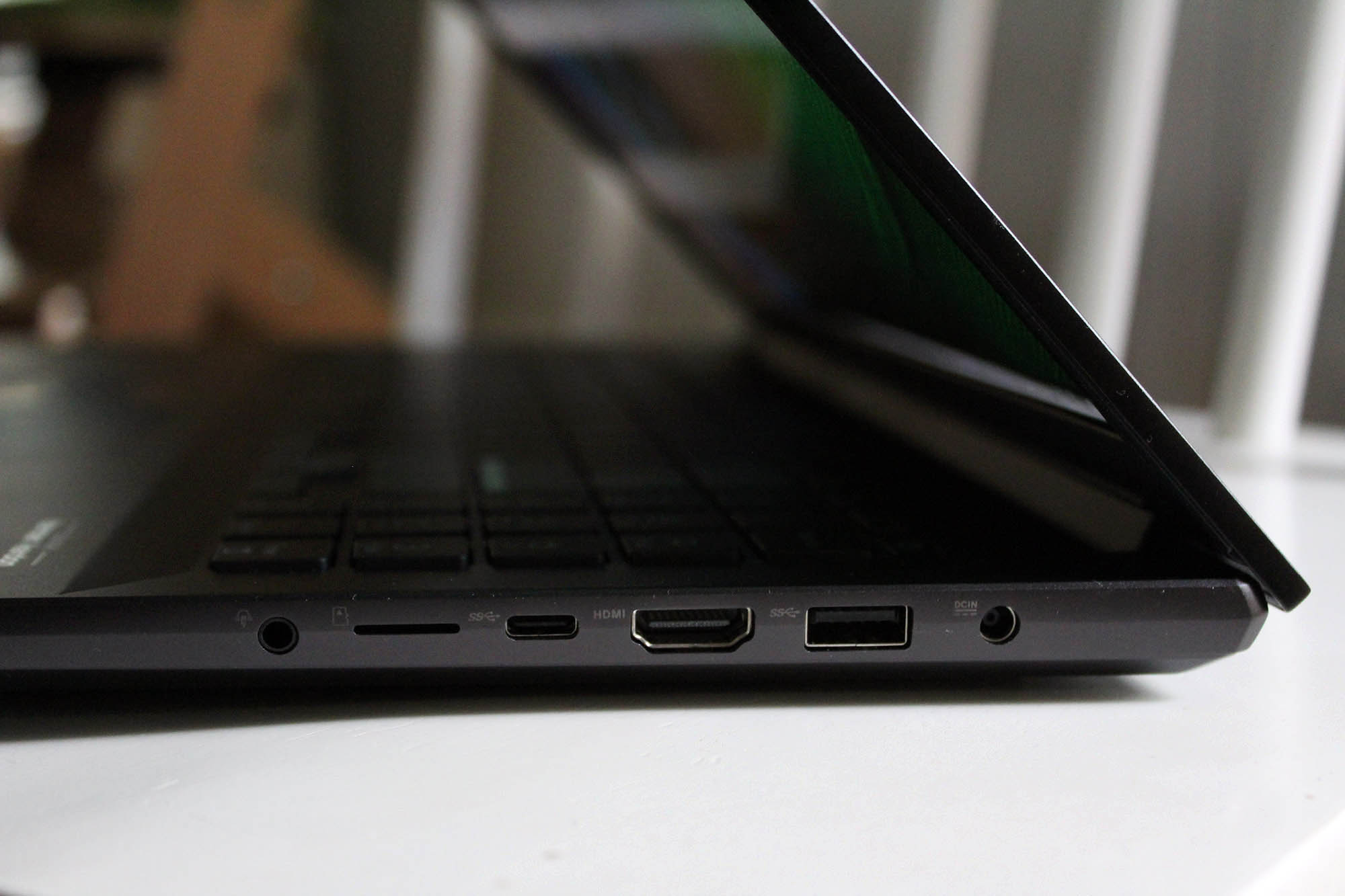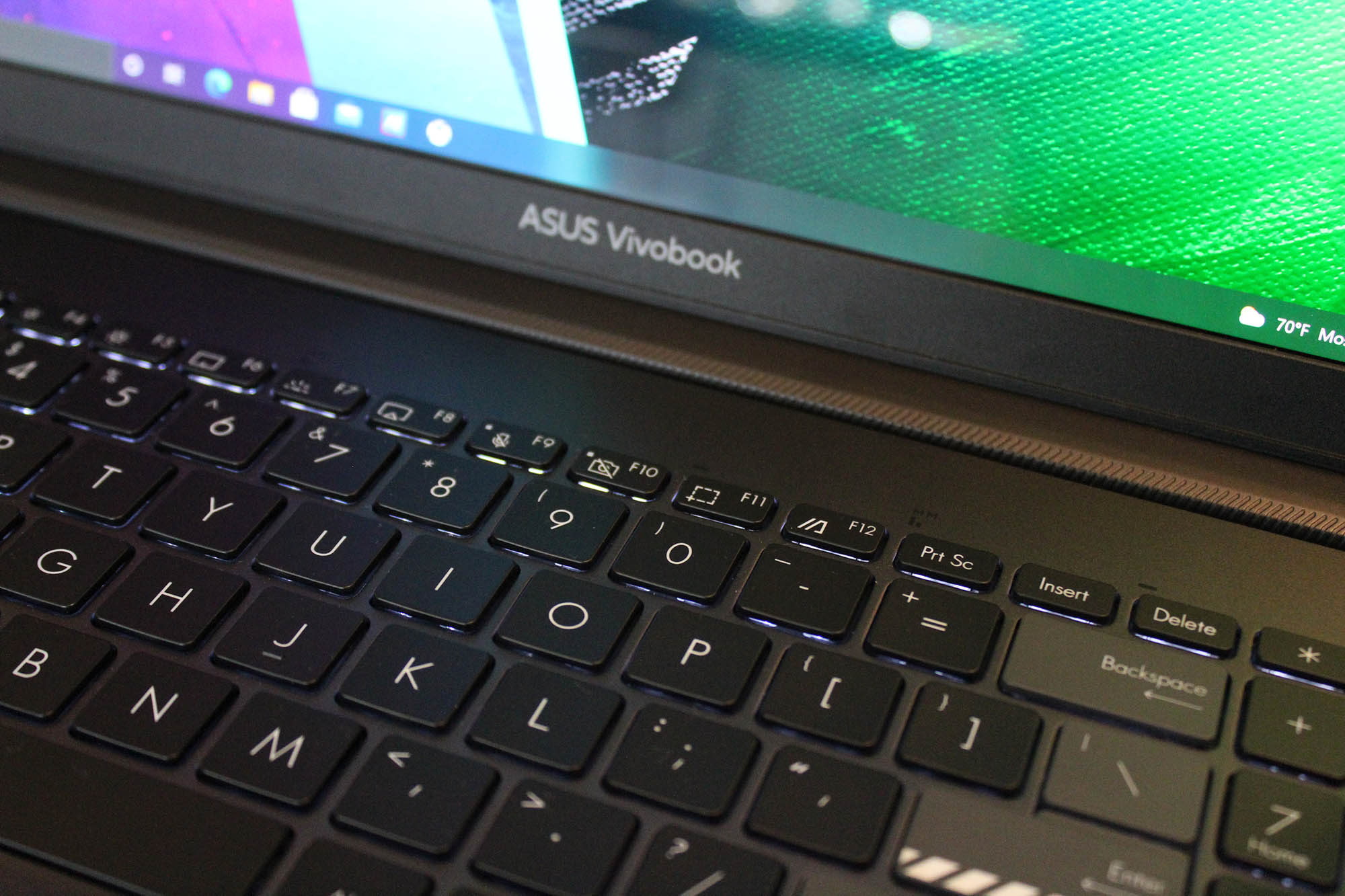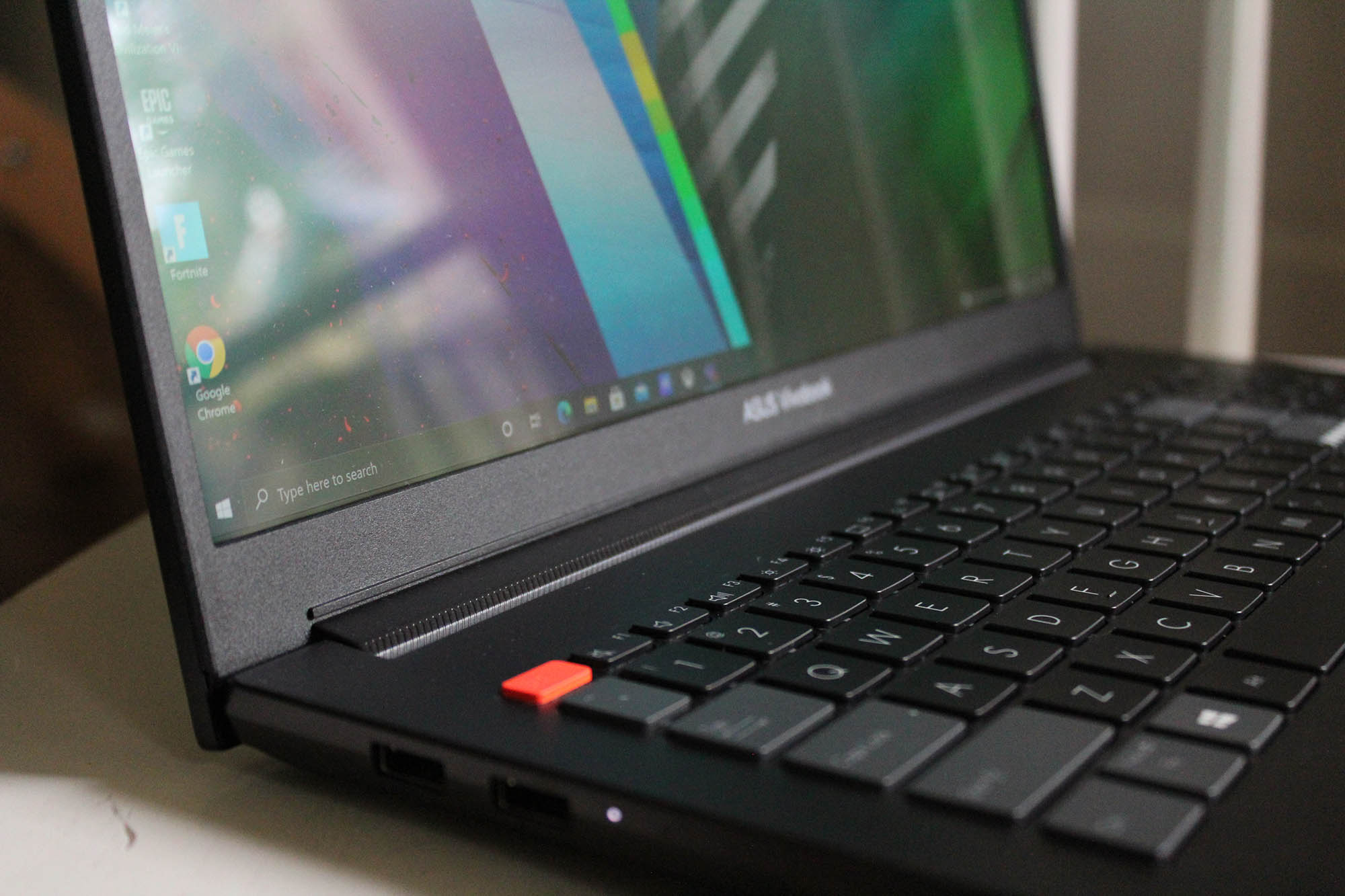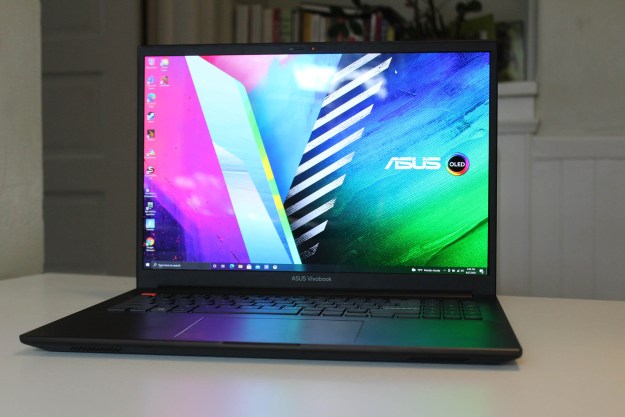
“The Asus Vivobook Pro 16X is everything a content creator needs in a laptop. And the price is right.”
- Unbelievable battery life
- Gorgeous OLED screen
- Powerhouse performance
- Great value
- A decent gaming machine
- Boring design
- DialPad feels gimmicky
Asus is on a mission to bring OLED laptops to the masses. The ZenBook 13 was the cheapest 1080p OLED panel we’d seen when it launched earlier this year, and now, the Vivobook Pro 16X is doing the same for 4K OLED.
The high-resolution screen comes in a base configuration that starts at just $1,100. In a world where OLED is typically reserved for laptops over $2,000, the Vivobook Pro 16X is a big step in the right direction.
Paired with a Ryzen 9 5900HX processor and RTX 3050 Ti graphics card, the ingredients are all in place for an excellent content-creation machine on the cheap. As it turns out, it’s exactly that — and much more.
Design

The design of the VivoBook Pro 16X is not its strong suit. It’s where the low price of the laptop rears its head. It’s not an unattractive laptop per se, more just a very basic one. The dark gray chassis doesn’t stand out much, and the fairly large, plastic bezels keep it from feeling cutting-edge. The few design flourishes it does have, such as the orange Esc key and the nameplate on the front bearing the phrase “#BeExplorers,” feel a little hokey.
The design just doesn’t have the premium look of some of its competitors, such as the Dell XPS 15, MacBook Pro 16-inch, or even the HP Envy 15. But again, this is considerably cheaper than many of those other options. Ultimately, the Vivobook Pro 16X is for those who prefer a cheaper laptop without taking a cut to performance. Design isn’t the priority.
Fortunately, that doesn’t mean the Vivobook Pro 16X is a poorly built machine. It’s plenty durable. It’s only weak spot is at the center of the lid along the hinge, but that’s typical. It’s an otherwise sturdy-feeling laptop to use and move around.

Asus also didn’t cut corners with portability. Despite being a very large laptop, the chassis is 0.74 inches thick and 4.3 pounds — a bit thicker than the XPS 15, but half a pound lighter than the HP Envy 15. The Razer Blade remains one of the thinnest options for laptops of this size and performance level.
One similarity the Vivobook Pro 16X has with the Razer Blade is that they’re both absolute fingerprint magnets. The lid, in particular, was quickly covered with fingerprints that were hard to remove.
Display

The Vivobook Pro 16X has a super-glossy OLED display, which is still fairly rare on laptops. You’ll find it as an option on the most expensive creator-based laptops, such as the Dell XPS 15. On that laptop, the cheapest you can configure an OLED screen is $2,300. HP can get you one on its Spectre x360 15 for $1,580. But $1,100? It’s unheard of, and yet, it’s exactly what the Vivobook Pro 16X accomplishes.
If you’ve seen any of the OLED screens on those laptops, you know what you’re getting with the Vivobook Pro 16X: Inky deep blacks, insane contrast, and a warm tint. Reds and oranges are cranked up, but not to the point of being unrealistic. You can force colors to pop even more with the “Vivid” color mode, found in the MyAsus application. You can also tweak the color temperature, either cooler or warmer. I’ve always found these Samsung OLED panels to be a bit too warm for my tastes, so being able to cool them down a bit is perfect. That piece of software also includes some OLED care tips, including pixel shifting, pixel refresh, and the ability to automatically hide the taskbar. These should, in theory, prevent any potential burn-in you might experience.
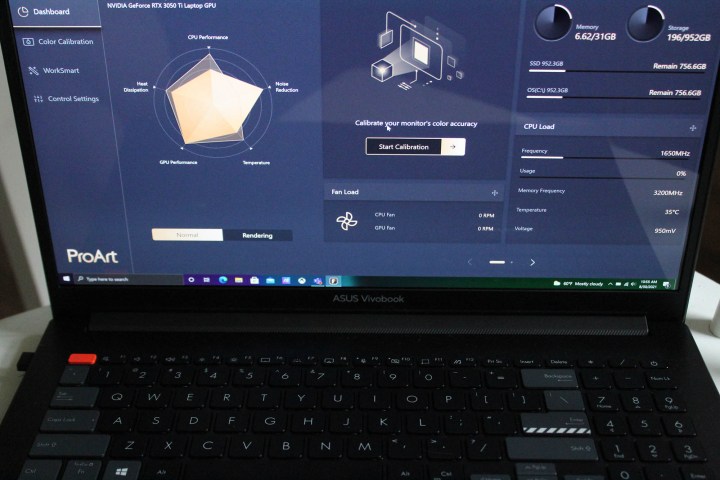
Using a Spyder colorimeter, I measured the color saturation, brightness, gamma, and color accuracy — and was impressed across the board. Again, this is nearly identical panel to what you find in other OLED laptops like the HP Spectre x360 15 or Dell XPS 15, and that’s a good thing. It hits nearly perfect in P3, AdobeRGB, and sRGB color spaces, and color error is low enough for more precise color grading. It just may be the best laptop screen I’ve ever tested — especially at this price point.
On top of all that, the Vivobook Pro 16X is the first laptop with a larger 16:10, 16-inch screen-to-feature OLED.
Ports
Asus keeps the port selection fairly simple, though it’s decidedly old school. That means you get three USB-A ports, HDMI, a barrel power connector, and just one USB-C port. Although the USB-C port can deliver power, Asus unfortunately chose to put it on the same side as the standard power connector.
The Vivobook Pro 16X also features a microSD card slot rather than a full-sized one. That’s a bit less convenient when uploading content straight from a camera, which seems like one of the primary uses for a laptop like this. That’s too bad.
The inclusion of the barrel plug is also not ideal. Laptops like the XPS 15 rely solely on USB-C power, and that seems to provide enough overall juice to the whole laptop without compromising performance. USB-C is not only more convenient, bt it also allows you to fully charge on either side of the laptop.
Keyboard and touchpad
Asus has done a good job with palm rejection, but accidental clicks are bound to happen once and a while.
Asus brought over the same keyboard from its higher-end ZenBook line. The keypresses feel snappy and the keycaps don’t have too much wobble. There’s not a ton of travel here, but I found it to be a fairly comfortable typing experience.
In addition to the orange keycap, the keyboard also features a racing stripe on the Enter key and some color distinction between. The keyboard includes a numpad, which makes sense for a laptop of this size. Laptops with a numpad often align the touchpad off-center to match the placement of your wrists when typing, but the Vivobook Pro keeps it centered. That’s nice visually, but it means your right hand rests on the touchpad while typing. Asus has done a good job with palm rejection, but accidental clicks are bound to happen once and a while.
Asus has been experimenting with new touchpad features over the last few years — whether that’s integrating a calculator or in putting a second screen. On the Vivobook Pro, it has something new called the DialPad. A swipe over the small icon in the top right of the touchpad will bring up a small digital dial on the left side of the touchpad. Once you start sliding your finger around the dial, it triggers an on-screen dial, letting you control various systemwide and app-specific settings. The default control are just volume and screen brightness, but there are a couple more options in the ProArt software to add. None of these were particularly useful, and certainly not more convenient than just using the keyboard.
However, the real use is for setting specific controls within applications, such as the Adobe Creative Suite. It’s all based around the same dial system created for the Surface Dial, which was introduced by Microsoft for the Surface Studio all-in-one. Asus’ new premium creative laptops in the StudioBook line make much greater use of the dial with physical controls and accessories. I could see someone using the DialPad for the occasional control tweak, but the combination of the swipe to trigger and the digital dial make for a clunky experience that would require significant habit-building to use effectively.
While I didn’t find the DialPad to be terribly useful, it also never got in the way either. Because it requires a swipe, I never had accidental launches.

Performance
The Vivobook Pro 16X earns its “pro” designation with two components. First, the AMD Ryzen 9 5900HX. This is a 45-watt, 8-core processor with tons of power behind it, especially in multithreaded tasks. It’s the same CPU we’ve seen in a number of excellent gaming laptops in 2021, and has been a winner across the board. Cinebench R23 multi-core results are impressive, stomping on Intel 11th-gen H-series laptops like the Dell XPS 15. Single-core performance is still slightly higher in Dell’s XPS laptop, but the Vivobook Pro isn’t far behind there either.
The Vivobook Pro also nudges out the XPS 15 in all PCMark 10 benchmarks, which include testing of basic tasks like web browsing and videoconferencing, as well as heavier workflows like multitasking and photo editing. It’s only 4% ahead overall — but remember, this is a much cheaper laptop we’re talking about. The Vivobook Pro is fast and snappy, whether you’re managing basic administrative work, playing games, or rendering a video timeline.
| Laptop | 3DMark Time Spy | Cinebench R23 | Geekbench 5 | PCMark 10 | Fortnite (1080p Epic) | Civilization VI (1080p Ultra) |
| Asus Vivobook Pro 16X (RTX 3050 Ti) | 4601 | 1486 / 11478 | 1544 / 8299 | 6287 | 57 fps | 68 fps |
| Acer Swift X (RTX 3050 Ti) | 4073 | 1437 / 10135 | 1287 / 6663 | 6247 | 43 fps | 66 fps |
| Dell XPS 15 (RTX 3050 Ti) | 4540 | 1513 / 9979 | 1556 / 7692 | 6024 | 50 fps | 73 fps |
| Dell XPS 17 (RTX 3060) | 7039 | 1525 / 10145 | 1568 / 8801 | 6209 | 78 fps | 104 fps |
Ultrathin 16-inch laptops like the LG Gram 16 also don’t compare well since they use a weaker 25-watt processor and integrated graphics. Gaming laptops such as the Ryzen-powered Razer Blade 14 or Lenovo Legion 5 Pro, though often far more expensive, have a similar performance range. The much larger XPS 17 is also a better one-to-one comparison in PCMark 10 with its RTX 3060 graphics.
For a similarly priced competitor, the Acer Swift X matches the Vivobook Pro’s performance in these benchmarks at a smaller 14-inch size. The Acer Swift X also features a Ryzen 5000 processor and the RTX 3050 Ti for graphics.
Seeing all this in real-life applications, of course, is what truly matters. And the Vivobook Pro didn’t disappoint. The great multi-core performance of AMD’s Ryzen 5000 chips allow for really fast video rendering that makes the Vivobook Pro super-fast in applications like Handbrake and Adobe Premiere Pro. Just how fast? Well, the Vivobook Pro 16X hit a new record for laptops at rendering in Handbrake based on our own testing.
This testing was all done on the system’s default “Standard” fan profile, meaning you can likely see improvements using the built-in “Performance” mode in Asus’ software.
The one exception I saw was in timeline playback in Adobe Premiere Pro. This is an area where Intel’s optimization has an edge over AMD. That means, overall, a laptop like the XPS 17 is going to perform better in Premiere Pro. You’ll also see slightly better overall Premiere Pro experience with a gaming laptop like the Lenovo Legion 5 Pro, which has stronger GPU performance with its RTX 3070.
But again, those aren’t fair comparisons to really make. When’s the last time you’ve heard of a $1,100 laptop that can handle 4K video edits like a breeze? That’s the Vivobook Pro for ya.
Gaming performance
Of course, with an Nvidia RTX 3050 Ti, you can’t not try out some games. And the Vivobook Pro 16X does better than you might think. The Vivobook Pro 16X does far more with the RTX 3050 Ti than some other laptops with that graphics card. It gets much better frame rates in games than smaller laptops with the same GPU like the Acer Swift X and the Asus ROG Flow X13.
You shouldn’t buy this laptop with gaming solely in mind, but it’s certainly powerful enough to handle modern games on the side.
In Fortnite, for example, the Vivobook Pro 16X is 25% faster than the Acer Swift X, averaging 57 frames per second (fps) in 1080p at Epic settings. That even beats the 50 fps that the Dell XPS 15 gets, also with the RTX 3050 Ti. That’s not bad, especially since the screen only has a 60Hz refresh rate.
The XPS 15 has the upper hand in Civilization VI, which is the other game I tested on the Vivobook Pro. While Dell’s system can play the game at a smooth 55 fps in 4K Ultra, the Vivobook Pro 16X was stuck with a choppy 39 fps. That advantage is less obvious in 1080p, where both systems easily landed at over 60 fps.
That makes the Vivobook Pro 16X a decent gaming machine, but not as good as an RTX 3060 laptop like the Dell XPS 17, of course. You shouldn’t buy this laptop with gaming solely in mind, but it’s certainly powerful enough to handle modern games on the side.
Speakers and webcam

There are two primary locations for speakers in laptops — either upward-facing right on the keyboard deck or along the edges, aimed down at the surface below. On the Vivobook Pro 16X, though, Asus chose a unique position — right along the front. If you’re reclining back while watching a movie or video, you’ll get some decent sound quality out of these speakers. It’s not the richest, most full-bodied audio I’ve ever heard, but it’s not bad.
Strangely, if you’re listening to something while typing or using the laptop, your arms will undoubtedly block the sound. An odd choice, no doubt, but they’ll get the job done while videoconferencing. Asus even includes some “A.I.-powered” noise-canceling for the microphones.
Speaking of videoconferencing, the webcam here is only 720p, so don’t expect the crisper image quality of one of the rare 1080p laptop webcams out there. I’ll say, though, that the Vivobook Pro’s imaging isn’t as bad as many of the other 720p webcams I’ve tested out. This is an example where the larger top bezel has allowed space for a higher-quality sensor than what is used in thin-bezel laptops like the Dell XPS 15.
Battery life
I couldn’t believe my eyes when I saw how long it lasted.
A 16-inch laptop with an RTX graphics card and a 4K screen that gets amazing battery life? Yep, this is it. The Asus Vivobook Pro 16X gets incredible battery life, despite having all of those factors working against it.
Asus didn’t get into the specifics, but this new OLED panel in the Vivobook Pro uses different materials when it comes to power consumption. The battery life improvements of using AMD’s Ryzen 5000 platform probably don’t hurt either. Whatever the secret sauce is — it’s working.

The Vivobook Pro 16X lasted over 16 hours on a single charge in our light web-browsing test. I couldn’t believe my eyes when I saw how long it lasted. It runs circles around laptops like the Dell XPS 15, which died after just five hours in the same test. It even beats the lightweight LG Gram 16, which was previously a battery life champion in this test.
The Vivobook Pro 16X even earned an extra 30 minutes in our lightest test, which loops a local video file.
Don’t expect to necessarily get two full days of work out of the Vivobook Pro, especially if your typical workload uses the discrete GPU. But you’ll be hard-pressed to find many laptops, especially not ones with this much performance, that can outlast the Vivobook Pro 16X on a single charge.
Our take
The Asus Vivobook Pro 16X OLED fills a wonderful niche in the laptop market. It boldly states that powerhouse performance and high-end displays don’t need to be reserved for those with deep pockets. There are still elements that separate this “midrange” laptop from the more expensive options out there, but none that will slow down your workflow or make you regret your purchase.
Are there any alternatives?
There are a host of larger laptops that are sold to a “content-creation” audience. The closest in price and performance is the HP Envy 15, though it’s not as powerful and is a bit more expensive.
The 14-inch Acer Swift X is a good alternative. Though it’s smaller, it features similar performance at almost the same price. It lacks the tremendous OLED screen, of course.
Lastly, if you have the money for it, the XPS 15 or XPS 17 won’t let you down — they’ll just cost you an arm and a leg.
How long will it last?
The Vivobook Pro 16X OLED should be a solid laptop for five or six years, though you won’t be able to get a warranty for that long. The components inside, though, are high-end and should be able adequately to power workloads, games, and applications for many years.
Should you buy it?
Yes. It’s a laptop with high-end components at an amazingly affordable price.


